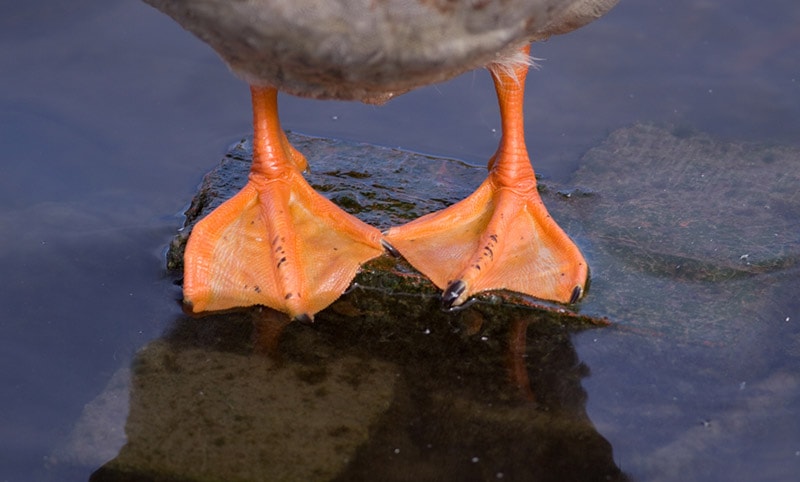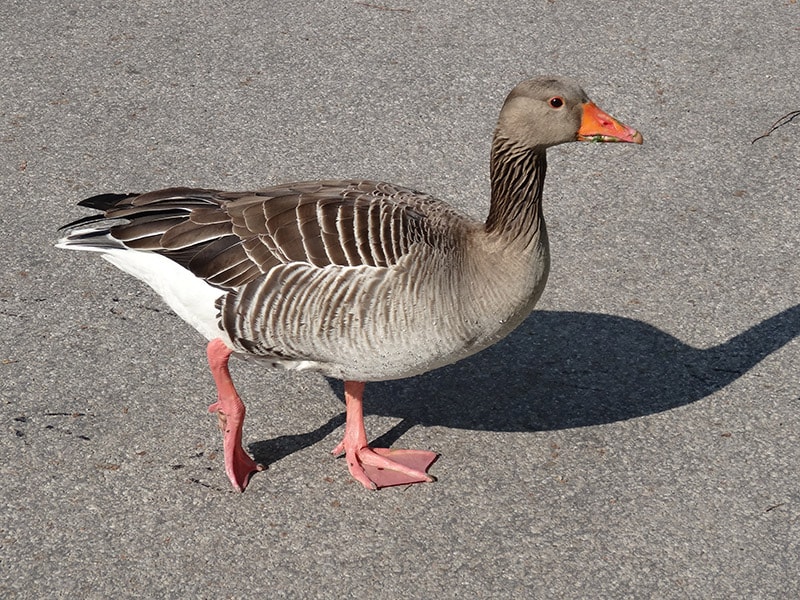Why Do Some Birds Have Webbed Feet? The Surprising Answer!
Last Updated on

Many of us have seen webbed feet on ducks, geese, and swans, but these are just a few examples of birds with webbing between their toes. Other webbed feet birds include gulls, penguins, and puffins. The webbing enables birds to swim faster and harder, either on or in water. It can also help water birds when they are on land, providing stability when walking on mud and other difficult terrains.
In some birds, webbing is found between all four toes, while some have webbing between the three front toes and the webbing itself is a combination of membrane, skin, and connective tissue. The webbing is used when the bird pushes its feet back in the water, increasing resistance against the water and allowing greater propulsion. As the bird moves its feet forward, it closes its toes together and reduces resistance.
Birds without webbed feet are able to swim, but they cannot usually do so comfortably or easily, and they will get fatigued more quickly.

What Are Webbed Feet?
Webbed feet are not uncommon in animals. A webbed foot has connecting tissue between the toes of the feet. When the toes are spread, the webbing fans out and increases resistance against the water. When the toes are closed, the webbing closes too, which reduces drag and enables the feet to move more easily.
Amphibians, including axolotls, have webbed feet, and so too do some mammals like otters. And while webbed feet typically aid with swimming, they can have other uses. Moles have webbed feet that help them dig. Even some dog breeds, especially those that have been bred to go in the water, like the Labrador, have partially webbed feet.

Types of Webbed Feet
In birds, there are two types of webbed feet. Palmate feet are those that have webbing between three of their four toes. Birds with palmate feet do not use the fourth toe for swimming or propulsion. Totipalmate feet have webbing between all four of the toes, all of which are used to assist in swimming.
How Do Webbed Feet Work?
Webbed feet assist in propulsion through water. When the bird spreads its toes, the webbing also spreads out. When they push their feet back through the water, the webbing provides resistance against the water, allowing them to push harder and propel further forwards with less effort. When the bird moves its feet forwards again, it closes its toes which enables the feet to pass through the water more easily.

The Benefits
Webbed feet in birds are primarily used to facilitate faster swimming for less effort. This enables birds like swans and geese to be able to swim longer without becoming fatigued. It also enables birds like diving ducks to be able to dive under the water and swim underwater.
Webbed feet can also help on dry land. Water birds typically have their legs and feet near the rear of their bodies. This helps with propulsion and swimming, but it can make balance difficult. Webbed feet help by providing greater stability on dry land and they are especially effective in mud.
Other Features That Improve Swimming
Webbed feet aren’t the only features that water birds have to assist with swimming.
Waterproof feathers, which typically have a natural oil that coats the feathers and prevents water from getting through to the body, keep the birds warm even when submerged in water.
As mentioned above, some water birds have their legs close to the rear of their body. This makes it easier to propel through the water because the bird can kick out and backward.


What Birds Have Webbed Feet?
Many water birds have webbed feet to aid in swimming and propulsion. Ducks, geese, swans, some cormorants, boobies, puffins, penguins, loons, and pelicans all have webbed feet.
Do All Water Birds Have Webbed Feet?
While it is true that many water birds have webbed feet, it isn’t true of all of them. The heron, for example, does not have webbed feet but is capable of swimming and getting around in the water. The heron uses its wings to propel itself through the water and its long legs to be able to stand in shallow water while it waits for prey to approach. American coots do not have webbed feet, either.

Conclusion
Webbed feet are a natural tool that helps water birds like ducks, geese, and swans to more efficiently and effectively get around in or on water. Some water birds use them to swim on top of the water while others use them to propel themselves underwater. They work by increasing resistance, therefore improving propulsion, and the webbed feet close to allow the feet to pass more easily through the water.
Although they are beneficial for swimming, webbed feet can help with balance on dry land, and not all water birds have webbed feet. Some, like the heron, use their wings to assist in greater propulsion.
Featured Image Credit: Chrispo, Shutterstock
About the Author Robert Sparks
Robert’s obsession with all things optical started early in life, when his optician father would bring home prototypes for Robert to play with. Nowadays, Robert is dedicated to helping others find the right optics for their needs. His hobbies include astronomy, astrophysics, and model building. Originally from Newark, NJ, he resides in Santa Fe, New Mexico, where the nighttime skies are filled with glittering stars.
Related Articles:
10 Types of Hummingbirds in Arkansas (With Pictures)
8 Types of Hummingbirds in Nebraska (With Pictures)
5 Types of Hummingbirds in Idaho (With Pictures)
3 Types of Hummingbirds in Mississippi (With Pictures)
8 Types of Hummingbirds in Kansas (With Pictures)
5 Types of Hummingbirds in West Virginia (With Pictures)
5 Types of Hummingbirds in Ohio (With Pictures)
Where Do Nuthatches Nest? Nuthatch Nesting Habits Explained
